Elliot's 5 fantasy baseball busts for closers. Avoid these overvalued relief pitchers in 2025 fantasy baseball drafts: Alexis Diaz, Robert Suarez, David Bednar, more.
Nothing worse than a headache in the bullpen. Nobody wants to draft the dud closer who loses his job in the first month or puts up a four+ ERA along with his save output.
In this article, I've identified five relief pitcher busts who are too expensive on draft day. These are guys that either have diminishing skills or could lose their grip on the closer job. These are pitchers to avoid drafting this season.
ADP is taken from NFBC and is accurate as of 3/19/25. For a deeper dive into ADP trends and strategies, check out our Fantasy Baseball ADP Guide to gain an edge on draft day.
Be sure to check all of our fantasy baseball lineup tools and resources:- Fantasy baseball trade analyzer
- BvP matchups data (Batter vs. Pitcher)
- PvB matchups data (Pitcher vs. Batter)
- Who should I start? Fantasy baseball comparisons
- Daily MLB starting lineups
- Fantasy baseball closer depth charts
- Fantasy Baseball live scoreboard
- Fantasy baseball injury reports
David Bednar, Pittsburgh Pirates
NFBC ADP: 184.63
Bednar was atrocious last season, posting a 5.77 ERA and 4.80 FIP in 57.2 innings. He was 23-of-30 on save chances and had a career worst 11.5% K-BB%. What went wrong for him in 2024? Everything went wrong for him in 2024. But I should probably be more specific, right?
The first problem we’ll address is his fastball, which had poor results against it last season. Batters hit .256 with a .459 SLG and .358 wOBA off Bednar’s fastball in 2024, a wOBA increase of 113 points from 2023. He earned these results, too, with a .244 xBA, .478 xSLG, and .363 xwOBA. The biggest issues with the fastball are a loss of movement (about an inch of vert and 0.6 inches of break) and poor placement. His zone rate went up to 54% last season. Let’s compare his fastball heatmaps from 2023 to 2024.
2023:
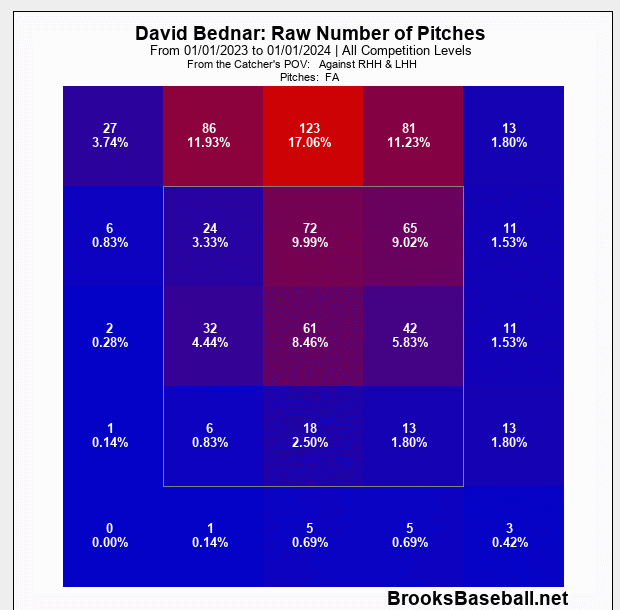
2024:
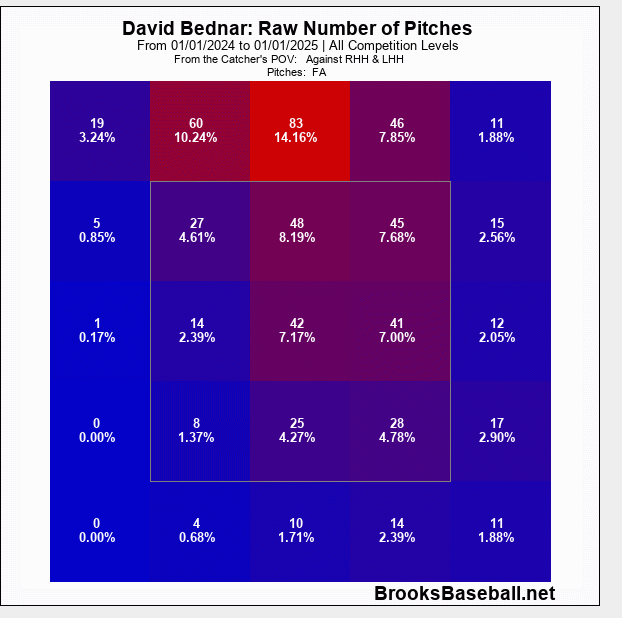
Maybe not a drastic difference, but notice how he lived more in the zone and threw the pitch lower in the zone in 2024. He can’t afford to throw too many pitches low in the zone like that. Please have a look at the ISO heatmap against his fastball last season.
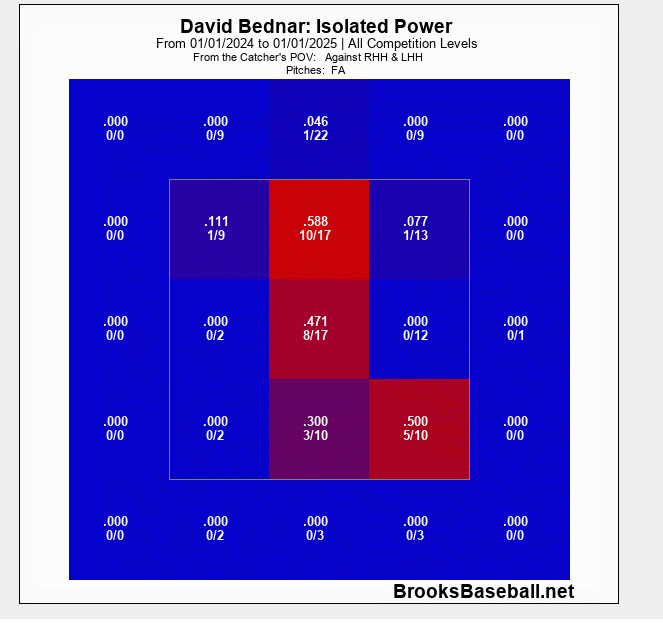
Batters crush the stuff inside the zone. He’s either missing his spots or taking a flawed approach. Seeing as his walk rate spiked to 10.7% last season, I’ll go with the former theory. Bednar has also had an awful spring, posting a 12.00 ERA and 9.7% walk rate in 7 appearances.
Bednar’s curveball also appeared off last season. In 2023, batters hit .196 against the pitch with a .268 SLG and .248 wOBA. Opponents also struggled against the curve last season with a .172 AVG, .310 SLG, and .258 wOBA, but his whiff rate plummeted. He had a 40.5% whiff rate with his curveball in 2023 but a measly 24.5% whiff rate with it last year. What changed? Let’s compare heatmaps again.
2023:
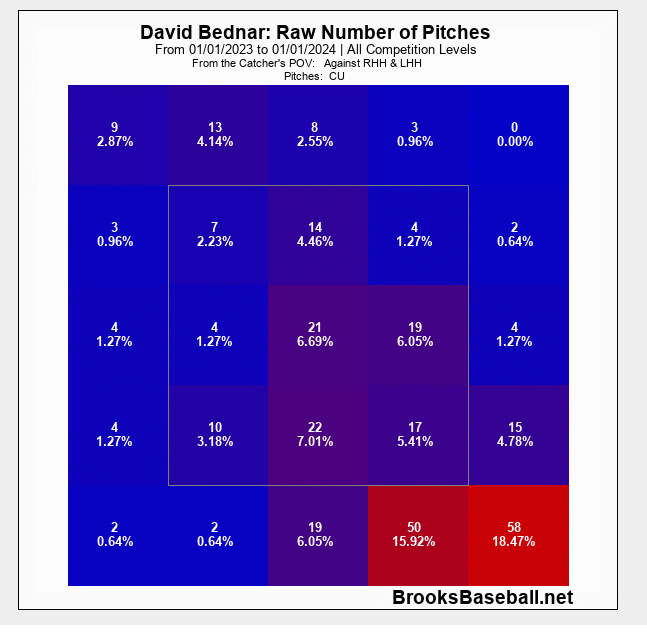
2024:
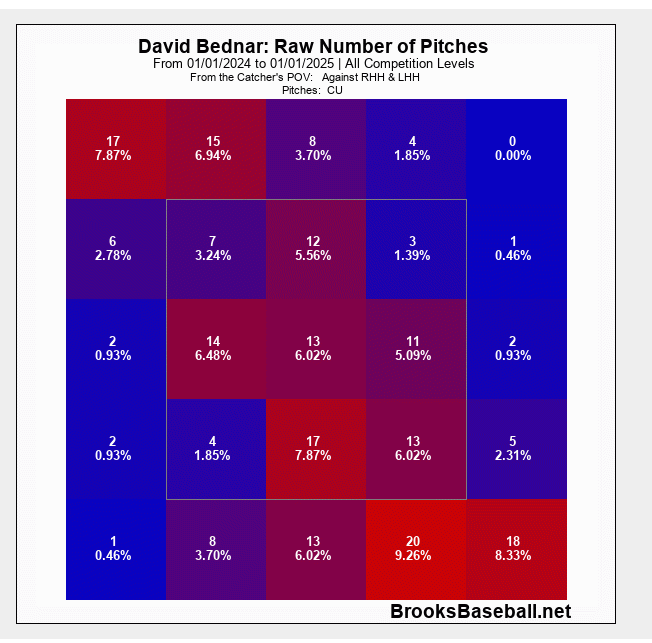
He was executing down and away in 2023, but he was all over the place in 2024. He seems to have lost his command, and that’s a dangerous game to play in the ninth inning. The one thing Bednar has going for him is a lack of competition. Colin Holderman or Dennis Santana are probably the next two options for Pittsburgh, but Holderman had a 4.26 FIP last season, and Santana has a 4.76 career ERA. This could be a messy situation during the season, and I’m going to try and avoid it.
Pete Fairbanks, Tampa Bay Rays
NFBC ADP: 184.38
Navigating the Rays' bullpen has proven vexing for fantasy managers at times, but things got a little easier for managers over the last two seasons as Fairbanks has emerged as the primary source of saves in Tampa Bay. He’s collected 48 saves over the past two seasons, with some impressive ratios along the way. Unfortunately, last season was the first time Fairbanks started to show some cracks.
The biggest issue for Fairbanks last season was health. He made two separate IL trips and only pitched 45.1 innings. I say “only”, but I should say career high because 45.1 innings tied for Fairbanks's career high last season. He’s been a huge health risk over his career, and he might not give us enough volume to impact our ratios positively in Roto.
Another concern for Fairbanks was his diminishing effectiveness last season. His strikeout rate plummeted to a pedestrian 23.8%, and his 2.59 K/BB ratio was a career worst. His velocity was down over a full mph, and he had just a 9.5% swinging strike rate. His fastball got crushed for a .280 AVG, .287 xBA, and .320 wOBA. Even worse, he had a .456 xSLG and .363 xwOBA against the pitch. Now, he has to pitch at Steinbrenner Field, which should be a better environment for opposing hitters.
Fairbanks was dominant prior to last season; he had a 2.66 ERA, 34.8% K rate, and 2.45 FIP between 2020-2023, so perhaps there’s hope he bounces back. His draft price is too high to bank on that, especially after his health woes and performance last season. He’s also issued four walks in 2.2 spring innings so far, so he’s not showing us that his control is back.
Fairbanks has competition in the bullpen, too. Keep an eye on Edwin Uceta. Uceta had a 1.51 ERA, 1.70 FIP, and 30.8% K-BB% in 41.2 innings last season. He could emerge as a closer candidate if Fairbanks struggles or gets hurt.
Ryan Pressly, Chicago Cubs
NFBC ADP: 311.33
The Cubs brought in the longtime Houston Astros closer to handle the ninth for them this offseason. Pressly is certainly experienced in the role, but his skills have diminished over the past few seasons. Last year had an unimpressive 3.49 ERA, 3.97 xERA, and 3.43 xFIP. He also had a 23.8% strikeout rate, his lowest since 2016 when hitters didn’t strike out as often.
Advanced metrics suggest that Pressly deserved the drop in strikeouts as well. His swinging strike rate fell to 12.6%, his chase rate dropped to 32.1%, and he didn’t have a whiff rate above 31% on any given pitch last season. He had a 44.7% whiff rate with his curveball in 2023 but just a 30.5% whiff rate in 2024.
Pressly also began relying on his fastball more often last season, throwing it 33% of the time, a 10% increase from 2023. The casualty was his slider, which went from 40% usage in 2023 to 28.9% in 2024. His breaking balls are his best pitches, so I’d rather see him lean heavily on the slider and curve rather than the fastball. Pressly’s fastball velocity dropped last season as well, going from 94.7 mph in 2023 to 93.8 mph in 2024, so it's not a great time to increase the usage.
Pressly’s fastball got crushed last season for a .313 AVG, .500 SLG, and .371 wOBA against, along with a blistering 94 mph average exit velocity. Yikes. He deserved these outcomes too, with a .288 xBA, .505 xSLG, and .365 xwOBA. Maybe he could recapture past success if he changes up his pitch mix, but his curveball and slider also performed poorly last season. Batters hit .244 off the slider and .245 off the curveball, an increase of 58 and 26 points from the previous season, respectively.
He’s not very expensive on draft day, but he’s still not someone I would draft. Fellow Cubs reliever, Porter Hodge, is going about 50 picks higher, and it’s easy to see why. Hodge had an impressive 1.88 ERA, 2.75 FIP, and 31.7% K rate last season. He’ll need to cut back on the walks (which he hasn’t done this spring), but Hodge seems like the superior pitcher at this stage. He’ll likely have better ratios and strikeouts and could even get more saves if Pressly falls apart.
Robert Suarez, San Diego Padres
NFBC ADP: 108.34
Suarez found a home at the back-end of San Diego’s bullpen last season, notching 36 saves in 42 opportunities with the Friars. His ratios were solid, too, with a 2.77 ERA and 1.05 WHIP over 65 innings. So, why is he a bust?
One thing I don’t like about Suarez is his poor strikeout rate. He had an underwhelming 22.9% strikeout rate last season. 22.9% is right around the league average, which is not what we want or expect from our closer. I want relievers with elite strikeout rates, and we won’t get that from Suarez. He has a career 25.9% K rate, which spiked to 31.9% in 2022. He’s been under 23% each of the last two seasons, and that’s what I’d expect for 2023.
Last season’s ERA estimators suggest that Suarez overperformed with a 2.77 ERA. He had a 3.49 FIP, 3.81 xFIP, and 3.53 SIERA. He benefited from a 9.5% HR/FB ratio, 80.8% LOB rate, and a .256 BABIP last season. It’s not as if he was egregiously lucky last year, but things could start to unravel if those metrics creep back towards league average.
Most projection systems have Suarez with an ERA above 3.50, with the BAT and ZiPs especially pessimistic with a projected ERA of 4.16 and 3.76, respectively. Those ratios are too high for a closer in Roto, especially just after pick 100. Why would I take Suarez at 108 when I could get Ryan Walker for the same price, or wait and draft Tanner Scott, Trevor Megill, Jeff Hoffman, or any number of relievers that I expect to give me better strikeouts and better ratios?
Suarez has also had an awful spring, sporting a 19.64 ERA in 5 appearances as of writing this, along with depressed velocity and a 16.7% walk rate. Spring results are only worth so much, but the reduced velocity and increased walk rate are both concerning.
The biggest thing Suarez has going for him is a stranglehold on the closer role in San Diego. But is that grip so tight? Setup men Jason Adam and Jeremiah Estrada were both impressive last season. Adam had a 1.95 ERA and 20.6% K-BB%, while Estrada had a nutty 2.95 ERA, 2.07 FIP, and 28.2% K-BB%. His K-BB% is better than Suarez’s raw K%. Even Adrian Morejon or Yuki Matsui could also be dark-horse candidates. The point is that the Padres have options if Suarez struggles. Suarez is not someone I would draft at cost; he would have to fall rather far for me to consider it.
Alexis Diaz, Cincinnati Reds
NFBC ADP: 171.71
UPDATE: Alexis Diaz has been placed on the IL.
Diaz is the incumbent closer for Cincinnati after earning 28 saves in 60 appearances last season. While the save output has been nice, Diaz wasn’t so kind to the ratios last year. He had a 3.99 ERA, 1.30 WHIP, and 9.9% K-BB%. Those aren’t exactly elite closer numbers. Diaz has been on a downward trajectory ever since his dominant 2022 rookie campaign, and 2025 might be the year the dam breaks.
The biggest issue for Diaz has been a bloated walk rate. He had a 12.8% walk rate last season, which matches his career mark. Despite being rather wild on the mound, he's always skirted by, but it gets tough to overcome such a high walk rate when his strikeouts and velocity dip.
Diaz had a strikeout rate above 30% in each of his first two seasons, but that fell all the way to 22.7% last season. The whiff rate on his slider dropped by eight percent from 2023 to 2024, and he lost an inch of vertical movement and an inch of horizontal movement with the pitch. Diaz’s slider no longer appears to be an elite strikeout offering, and as a two-pitch pitcher, he cannot afford this.
His fastball velocity has declined in each of his three seasons, falling to 94.1 mph last year. The whiff rate also fell 8% to a mediocre 23.7% in 2024. Another area of concern is an increase in flyball rate. His flyball rate went up to 47.6% in 2024, and he allowed 0.96 HR/9 as a result. That may not seem too high, but it’s scary to have such a high home run rate for a wild closer like Diaz, especially pitching half his games in the Great American Ballpark.
To recap, Diaz’s strikeout rate has plummeted, his velocity has dipped, he’s always issued too many walks, and now he’s a home run risk. I’d like to avoid that on draft day, even if he gives me 20-25 dirty saves with bad ratios.
Something else to consider is that Cincinnati has a new manager. Terry Francona may not have the longest leash for Diaz. Cincy doesn’t have a ton of great alternatives, but veterans Taylor Rogers, Emilio Pagan, and Scott Barlow could be options if they move off Diaz. Considering how precarious his job and skills seem, he's too expensive on draft day. No thanks.
Download Our Free News & Alerts Mobile App
Like what you see? Download our updated fantasy baseball app for iPhone and Android with 24x7 player news, injury alerts, sleepers, prospects & more. All free!

 RADIO
RADIO
























